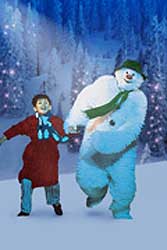 A moving modern classic children's book by Raymond Briggs 1978 wordless picture book The Snowman was adapted as an animated version in 1982, without loss of anything the book presented. In fact, because of the harrowing & perfect marriage of music to animation, the half-hour film is a wonder. (As an aside, a 1990 revamping of the book has words; it's not the version to look for.)
A moving modern classic children's book by Raymond Briggs 1978 wordless picture book The Snowman was adapted as an animated version in 1982, without loss of anything the book presented. In fact, because of the harrowing & perfect marriage of music to animation, the half-hour film is a wonder. (As an aside, a 1990 revamping of the book has words; it's not the version to look for.)
Starting with what may well be the best book ever illustrated about a snowman coming to life, it has been fashioned into one of the best animated films imaginable.
The soundtrack written by Howard Blake suits the muted colors & soft-focus animation to create a winter moodiness. I do think it may be one of the most appropriate scores I've ever heard in a film, so enhancing the animation that for once there's a film adaptation in no wise inferior to the book.
This is the handsomest snowman, a simple, rotund, pleasant figure who is exactly the sort of fellow a child must imagine coming to life. That night, the boy creeps out of bed to see if his snowman is all right, & sees a sparkle from within him just before he turns about & tips his hat.
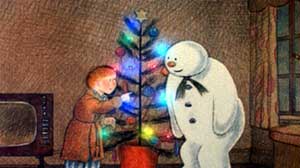 The child invites the snowman into the house to see the christmas decorations, how the television works, how to operate light switches, & the sink. The child invites the snowman into the house to see the christmas decorations, how the television works, how to operate light switches, & the sink.
The warmth of the fireplace seems to bother him a bit, but mainly melting isn't an issue for this snowman, the magic that brought him to life keeps him from leaving puddles of himself everywhere.
A creature of enormous curiosity with an appreciation of everything he encounters, the bulk of the cartoon is just a delightful piece of mime with a joyful imaginary friend.
Gazing from an upstairs window, he sees dad's motorcycle under a tarp, & so they go back outside & the music swells as the snowman starts the motorcycle & takes the lad for a remarkable night-ride through a forest of beasts & shadows, a magic ride without bumps or fences.
Up to now the film has been glorious, but for the last ten minutes it turns into the most remarkable dream of beauty & wonder as the snowman discovers he can fly.
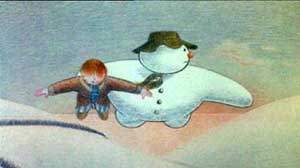 To the film's spectacular themesong "Walking in the Air" sung by a boy named Peter Auty, the snowman takes the lad by the hand & whisks him across the world, through snowfall, with occasional witnesses on the ground, through the northern lights: To the film's spectacular themesong "Walking in the Air" sung by a boy named Peter Auty, the snowman takes the lad by the hand & whisks him across the world, through snowfall, with occasional witnesses on the ground, through the northern lights:
"We're walking in the air/ We're floating in the moonlit sky/ The people far below are sleeping as we fly./ I'm holding very tight/ I'm riding in the midnight blue/ I'm finding I can fly so high above with you.
"Far across the world/ The villages go by like trees/ The river & the hills, the forest & the streams/ Children gaze open mouth/ Taken by surprise/ Nobody down below believes their eyes.
"We're surfing in the air/ We're swimming in the frozen sky/ We're drifting over icy mountains floating by/
"Suddenly swooping low on an ocean deep/ Arousing of a mighty monster from its deep/ We're walking in the air/ we're floating in the midnight sky/ And everyone who sees us greets as we fly."
They land in a distant northern forest. There, Santa is throwing a feast & a dance for the snow people, & the lad joins the dances, receives the gift of a scarf directly from Santa, pets the reindeer, but must before dawn be returned home by the snowman whose life was for this night only.
And when the lad awakens from this dream, to a depth of sorrow, he has the scarf from Santa as evidence that dreams are real.
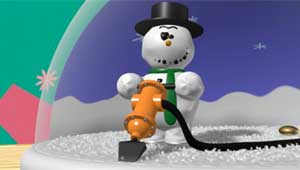 The soullessly computer-animated snowman cartoon Knick Knack (1989) premiered in 3-D at the 1988 Siggraph Animation Show.
The soullessly computer-animated snowman cartoon Knick Knack (1989) premiered in 3-D at the 1988 Siggraph Animation Show.
In 2003 it was released on DVD as an extra with Finding Nemo, digitally altered to be "more suited" to children apparently, which meant reducing the size of the mermaid's breasts. But the spirit of the thing, which is drunken fratboys, remained intact.
A rather ugly snowman, inside a snowglobe, sees some tropical travel souvenirs outside his globe. He wants to get out of the globe to join their party.
The fact that he can't do so I guess is supposed to be sad as well as funny, but the computer animation is devoid of emotion or character, so it's neither sad nor funny.
Knick Knack almost has a happy ending but with a har-har-har on the filmmakers' part, so it ends badly for the wee snowman. Such an soulless cartoon, the misplaced pride Pixar studios has expressed in it speaks volumes.
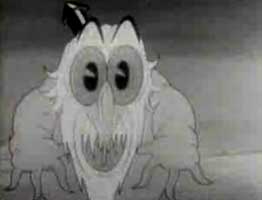 In the frozen north, an eskimo boy puts his seal puppy outdoors, with a hot water bottle, then himself turns in for the long night, setting his clock to the month the sun returns. He sleeps from January to June before the clock's s team whistle gets him up.
In the frozen north, an eskimo boy puts his seal puppy outdoors, with a hot water bottle, then himself turns in for the long night, setting his clock to the month the sun returns. He sleeps from January to June before the clock's s team whistle gets him up.
He goes out to get his pup, which itself now has pups. The pup with the little pups skip along the Arctic snows with lots of sights with Polar bears, brown bear cubs, birds, fish dancing around an ice-hole, & penguins who don't know they don't live in the northern arctic.
The eskimo boy finally builds a snowman, with help of a baby bear & a pelican. Unexpectedly the snowman comes alive, not a friendly Frosty, but as a hideous snow giant that goes on a rampage trying to kill the little boy & all the beasties.
Then straight out of left field, the snow giant hears a hymn sung in a church made of ice. Inside a walrus plays an icy pipe organ & a chorus of penguin chicks sing "Come come come come come to the church in the wildwood" though there certainly aren't any woods around this one.
The ice man breaks into the church, frightens everyone away, & sits down with gleeful evil laughter at the organ & rips out the keys. So ends that odd gag, as now he heads out to a lake (not frozen) to menace a Bambi type deer & other animals, who are beginning to unite against the monster.
The eskimo lad in a kayak is zipping along past icebergs then rides a polar bear over land, arriving at a cavern laboratoratory which operates the Northern Lights. He turns the Northern Lights on maximum (they're begging to be colorized but fortunately the cartoon's still in b/w) & the monster melts away, hooray.
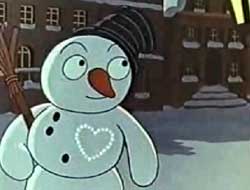 Snowflakes fall upon a snowman's chest in the shape of a heart, which brings him to life. He opens one eye, then the other, & is instantly pleased by all he sees. He plays with snow. He jugles his hat, some snowballs, & a broom. He outwits a dog. He goes skating. Life is joyful.
Snowflakes fall upon a snowman's chest in the shape of a heart, which brings him to life. He opens one eye, then the other, & is instantly pleased by all he sees. He plays with snow. He jugles his hat, some snowballs, & a broom. He outwits a dog. He goes skating. Life is joyful.
We're watching the thirteen-minute cartoon Der Schneemann (1943), made in color in Nazi Germany, when nearly all films had to serve one or another propagandistic purpose to get made. Yet animator Hans Fischerkoesen made several theatrical cartoons which, despite Nazi scrutiny, managed to avoid any hint of propagandistic messages, beyond that of blind optimism about the goodness of life.
He was in fact a member of an anti-Nazi underground, but the Soviets nevertheless imprisoned him after the war for having made cartoons the Soviets decided, sight unseen, had to have been propagandistic. He was released after three years, & escaped with his family to West Germany where he again pursued his love of animation.
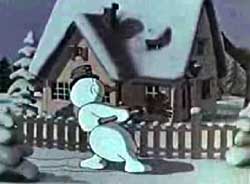 The film has no dialogue so works as an international production. It was first seen in the United States in 1944, after copies were obtained by the allies, & was exhibited quite appreciatively under the title Snowman in July. In the 1950s it was syndicated to television as The Snowman. The film has no dialogue so works as an international production. It was first seen in the United States in 1944, after copies were obtained by the allies, & was exhibited quite appreciatively under the title Snowman in July. In the 1950s it was syndicated to television as The Snowman.
Our living snowman has his primary brush with misery when he falls through lake ice & loses about eighty percent of his body mass, coming out of the water more icesickle in tophat than snowman. He staggers miserably across the snowy countryside, collapsing from weakness, rolling down a hill, being thus restored to his former bulk as he rolls.
Sleeping under the full moon, he awakens in time to keep a rabbit from eating his carrot nose. In the shadowy dusk, he comes upon a lovely cottage, & goes inside, delighted by the furnishings. On the wall he finds a calendar hung open to "January" with a picture of a snowman not unlike himself.
He takes it from the wall & begins to thumb through the pages until he comes to July. The image of summer with all its garden flowers fascinates him, & he begins pondering.
He seems to know he'll be melted long before summer, but that's just the way of things, & he does not seem frightened or worried. Rather, he just wonders how he can extend his existence a little beyond the norm, so that he can see summer for himself.
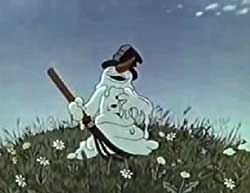 He climbs into an ice cooler to hibernate, awaiting the arrival of summer. We're treated to animated images beyond the cottage, of spring's pussy willows opening on branches, snowdrops & other flowers bursting from the soil, as the snowman sleeps on in the icebox. He climbs into an ice cooler to hibernate, awaiting the arrival of summer. We're treated to animated images beyond the cottage, of spring's pussy willows opening on branches, snowdrops & other flowers bursting from the soil, as the snowman sleeps on in the icebox.
Then comes summer, when the snowman awakens & sets forth as witness to sunflowers, daisies, & roses like those he saw on the July page of the calendar
.
Happily he dances out out into the sun to smell the flowers with his carrot nose, playing with a ladybug, sommersaulting in the flowery meadow, skipping down a dirt road & rolling in a field of wheat.
He has many sweet adventures & in the end opens his arms to the sun & sings in German about "the summer of my life" -- this song being film's only dialogue -- as he melts away devoid of sorrow or regret.
When he's gone, the rabbit who had once tried to eat his nose finds the carrot in the grass, & eats it with tears in her eyes, as her baby bunnies climb playfully into the snowman's tophat.
copyright © by Paghat the Ratgirl
|
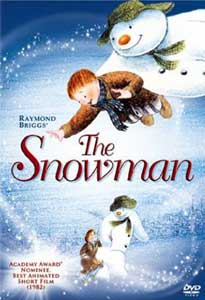

 The child invites the snowman into the house to see the christmas decorations, how the television works, how to operate light switches, & the sink.
The child invites the snowman into the house to see the christmas decorations, how the television works, how to operate light switches, & the sink. To the film's spectacular themesong "Walking in the Air" sung by a boy named Peter Auty, the snowman takes the lad by the hand & whisks him across the world, through snowfall, with occasional witnesses on the ground, through the northern lights:
To the film's spectacular themesong "Walking in the Air" sung by a boy named Peter Auty, the snowman takes the lad by the hand & whisks him across the world, through snowfall, with occasional witnesses on the ground, through the northern lights:


 The film has no dialogue so works as an international production. It was first seen in the United States in 1944, after copies were obtained by the allies, & was exhibited quite appreciatively under the title Snowman in July. In the 1950s it was syndicated to television as The Snowman.
The film has no dialogue so works as an international production. It was first seen in the United States in 1944, after copies were obtained by the allies, & was exhibited quite appreciatively under the title Snowman in July. In the 1950s it was syndicated to television as The Snowman. He climbs into an ice cooler to hibernate, awaiting the arrival of summer. We're treated to animated images beyond the cottage, of spring's pussy willows opening on branches, snowdrops & other flowers bursting from the soil, as the snowman sleeps on in the icebox.
He climbs into an ice cooler to hibernate, awaiting the arrival of summer. We're treated to animated images beyond the cottage, of spring's pussy willows opening on branches, snowdrops & other flowers bursting from the soil, as the snowman sleeps on in the icebox.